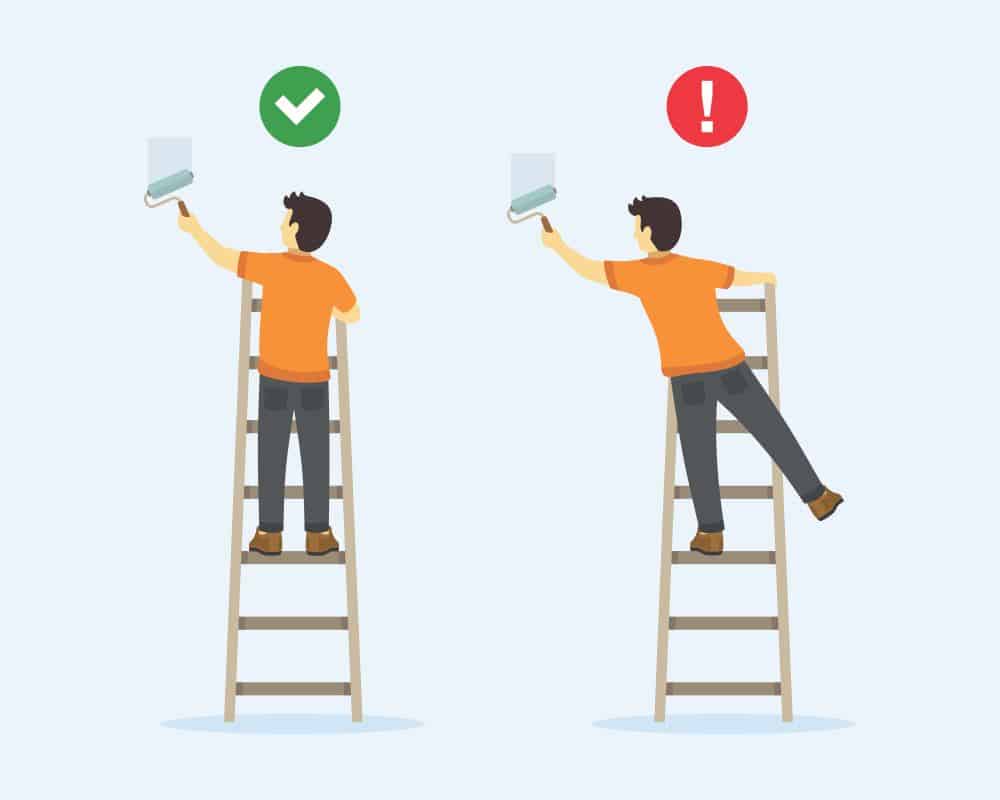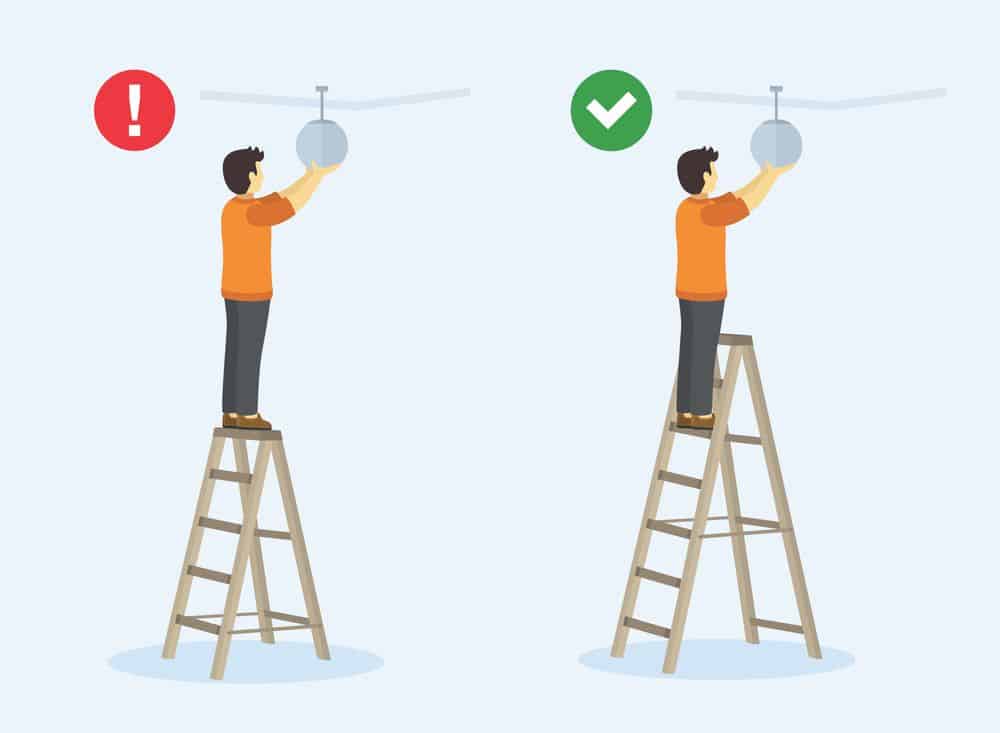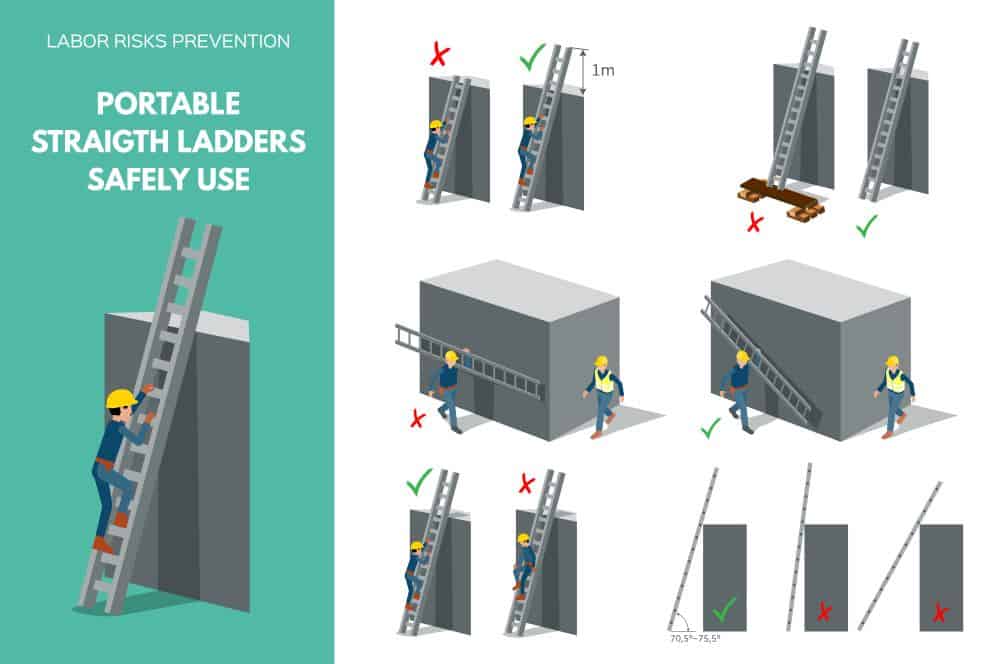According to ladder safety statistics, at least 300 people die each year from ladder falls and accidents. Also, 164,000 emergency injuries are recorded annually because of ladders. Therefore, safety should be the top priority when using a ladder.
Here are 11 important ladder safety tips you must read before climbing any ladder. So, without any further ado, let’s dive into it.
Ladder safety tips – Explained in Details
1. Ensure ladder inspection requirements
Before using a ladder, the first thing to do is inspect for any red flags. You need to check for cracks and splits, rust, corrosion, and bolts that are not in place.
Also, check that the rungs are correctly secured to both sides of the ladder. All locks and hinges should be functioning seamlessly before using the ladder.
Any damage, no matter how small, indicates an unsafe ladder. You should only use the ladder if all the safety requirements are met.
Ladder rung spacing is also a matter that requires attention. Using that ladder is risky if you are comfortable with the rung spacing.
2. Maintain 4 rules for ladder safety
The ladder should maintain a 75-degree angle from the wall. You may know this as the 4:1 ratio or 4 rules for ladder safety. What does this mean?
If your ladder is going to be 12 feet high, the distance of the base from the wall should be three feet.
You can measure this by standing straight with your toes at the bottom of the ladder. When you stretch out your arms, they should rest on the rungs at your shoulder height without overreaching.
We recommend maintaining an ideal ladder angle.
3. Maintain the 3-point rules when climbing
Always climb the ladder with two hands and one foot on the ladder or two feet and one hand in contact with the ladder. Mai training contact with the ladder will help you remain steady.
Also, keep your weight centered between the rails to avoid toppling over.
4. Extend the ladder over the roof
If you plan to clean your gutters or fix the roof using an extension ladder, ensure that the ladder is extended over the room.
Ensure that you extend the ladder at least one meter over the roof. If you climb onto the roof from the ladder, climb from the second-highest rung, not the top rung.
An extension ladder is more likely to lead to an accident, so you must follow safety tips.
While you are specifically looking for a ladder to clean your gutters, this article will help you.
5. Keep the ladder on a stable footing
Although some ladders have rubber feet to prevent slipping, it is essential to ensure firm footing when working on them.
It’s even more critical when working on unstable or uneven ground, such as muddy or sloppy ground.
Set the ladder’s feet on a non-slip carpet or plywood board staked to the ground for stability.
You can also secure the ladder using unique straps for additional stability or get someone to hold it in place as you use it.
Learn more about how to secure a ladder for the highest level of safety.
6. Cover the top ends of the ladder
If you use an extension ladder to access high walls, remember that it can slide against the wall or slide it on.
You can tie some old socks or rugs on either side of the ladder to prevent skidding. You can also purchase some rubber covers to put over the ends.
Never lean your ladder against doors, windows, or unstable surfaces.
Learn more about the safe use of ladders.
7. Use rubber shoes when climbing a ladder
Although some ladders have non-skid rungs, it’s essential to wear rubber shoes as a precaution. The shoes add traction to the ladder and keep you from slipping when climbing or using it.
Ensure that the boots have deep treads for maximum stability. Do not climb a ladder barefoot, with high heels or improper shoes.
8. Avoid overreaching
Overreaching has got to be the biggest sin in using ladders. Do not use the first three rungs of a ladder unless they are designed for use.
It does not matter whether you use an extension or a step ladder to a frame.
The top rungs of the ladder can lead to accidents due to loss of balance. It’s also very risky to improvise using boxes and blocks of wood to create extra height on the ladder.
These items can collapse and lead to falls. Our research has revealed some scary findings: people try to overreach the heights using a tiny step ladder, which is very dangerous.
So, we motivate you to follow step ladder safety tips while using one. But if you need access to the top corners of your home or workplace, you need a proper ladder.
We have also published a resourceful handy reviews of the 9 best indoor ladder for high places, don’t forget to check that out.
9. Do not exceed the maximum load rating of the ladder
Every ladder has a weight rating that determines how much weight the ladder can withstand before collapsing. You must ensure that your ladder can hold your weight and load, if any.
Using a ladder that cannot withstand your weight could cause the ladder to break and cause an accident. A type I (heavy-duty) or type II (medium-duty) ladder is recommended, even if you are featherweight.
Avoid light-duty ladders at all costs.
10. Be informed about the weather before using a ladder
Working on a windy or rainy day on the ladder is dangerous since it causes instability. Severe heat or cold also makes it uncomfortable and hazardous to work on a ladder.
Therefore, you must watch the weather forecast before setting a ladder date. A dry, mild, windless day is ideal for repairing your roof or cleaning the gutters using a ladder.
Using a ladder on the soft, muddy, or icy ground can expose the user to extreme danger.
It’s also advisable to follow portable ladder safety guides while using any because portable ladders are a bit more fragile than others.
11. Store the ladder in a safe place – it’s a part of ladder safety
The ladder, made of wood, aluminum, or stainless steel, should be stored in a dry place to avoid rusting, corrosion, or damage.
The ladder should be repaired, cleaned, and dried appropriately before storage. It’s also essential to keep the ladder in a lockable garage, as burglars can use it to access your house.
Here is a bonus point on ladder safety tips
Do not shift a ladder with someone on it to ensure maximum ladder safety
Whether your ladder has wheels or someone is holding it firm, moving around with someone or a load on it is hazardous.
The person may fall off, or the load may fly down and hurt you.
So, whether you are a professional or working at home, these ladders offer safety tips to help you stay safe.
We highly recommend following ladder safety tips at home because we have seen that ladder safety guides are more ignored at home by owners than professionals in the workplace.
Follow them to the ladder to prevent workplace hazards and accidents. Also, ensure that you purchase a ladder that is safety-certified and from a reputable seller.
In addition to that, you should follow a trustworthy ladder safety handout, which you generally should be provided by the manufacturers. Follow this link to learn more insights.




